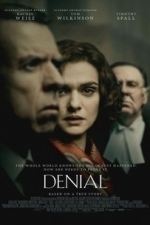Darren (1599 KP) rated Denial (2016) in Movies
Dec 28, 2019
Story: Denial starts when acclaimed writer and historian Deborah Lipstadt (Weisz) has her latest book about the horrors of the Holocaust being released, only her in her book to slams historian and renowned denier David Irving (Spall). David Irving has built up a reputation for being able to fight his case and decides to sue Deborah for libel.
After the years or preparation Deborah watches how Anthony Julius (Scott) and Richard Rampton (Wilkinson) look to make a trial where Deborah will win, without having to put the holocaust on trial, they want to keep it together for argument, with the case being about proving David’s research, rather than whether the holocaust happened.
Thoughts on Denial
Characters – Deborah Lipstadt is an acclaimed author that has made her career out of writing about the horrors around the holocaust, this has created an enemy in David Irving, that she has always been denying the holocaust happened. She must defend her own accusation against him, putting her trust in a group of lawyers to fight the case, despite the fact she would like to put the spotlight on the events, over the facts being disputed. Richard Rampton is the lawyer that is running the case in the courtroom, he has methods that Deborah doesn’t like, until she sees how he has truly been planning the case. Anthony Julius runs the case behind the scenes, he has a huge reputation with his previous work which made headlines and must be strict towards Deborah over what she wants to happen in the case. David Irving is the famous Holocaust denier, he has made a career out of his theories, which has given him a huge following, he decides to sue Deborah for criticising his beliefs, where he uses his natural charisma to get people behind him, despite his anti-Semitic behaviour being clear to see.
Performances – Rachel Weisz in the leading role is great to see, she shows just how helpless Deborah looks during the case, that puts her own reputation on the line. Timothy Spall steals the show with his depiction of David Irving, showing how he is the more colourful character in the case. Tom Wilkinson shows he will always be able to bring a quiet character to life in the moments he needs to shine, while Andrew Scott proves that his rising star will get involved in the major performances.
Story – The story here follows Deborah Lipstadt who has her own book sued for libel by holocaust denier David Irving, forcing them into a court case, which will be about whether he has been making up the truth for his own benefit or whether she had the right to question his beliefs. The story is an interesting one to follow, seeing an conspiracy theorist being put in a courtroom to prove his fictional story about the truth is fascinating to see, having a court case just about whether something as horrific as the holocaust is bad enough, but seeing how everybody seemed to have a fine balance between who could win, was also interesting. The story does struggling to start with, because of the large number of time jumps, with it starting in 1994, before the case happening in 2000, with small scenes in the build up to the case, through the years, but once we get into the courtroom, we are grasp by the story.
Biopic – The biopic side of the story focuses more on the case, rather than the people involved, which could take away just how much the case did take out of the people involved.
Settings – The film does use the courtroom as the main location for the story to move forward, with most of the external locations being ideas of where the story could end up going, with most being office, apart from the haunting trip to Auschwitz.
Scene of the Movie – The court case.
That Moment That Annoyed Me – The early time jumps, we seem to have one scene, then jump two more years down the line.
Final Thoughts – This is an interesting courtroom drama, that shows how the truth managed to get all the way to a courtroom, when it was clear it happened, showing even conspiracy theorist could challenge the truth.
Overall: Interesting, but not Intense drama.
Bob Mann (459 KP) rated Hell or High Water (2016) in Movies
Sep 29, 2021
This week I have had the chance to catch up on two of the films with award potential that I missed at the cinema, and this is the write up of the first of those: “Hell or High Water”, was first released in September 2016, and what an excellent film it is.
Bank robberies have been featured in many hundreds of films since the early days of cinema: The Great Train Robbery for example dates back to 1903! More recent heist classics such as “Oceans 11”, “Die Hard”, “Run Lola Run” and “The Dark Knight Rises” tend towards the stylised end of the act. Where this film delivers interest is in aligning the protagonists’ drivers with the banking and mortgage ‘crimes’ featured in last year’s “The Big Short”. Add in to the movie Nutribullet a soupçon of the West Texan setting from Arthur Penn’s 1967 “Bonnie and Clyde”, turn it on and you have “Hell or High Water”.
Chris Pine (“Star Trek”) and Ben Foster (“Inferno“, “The Program“) play brothers Toby and Tanner Howard trying to rescue their deceased mother’s ranch from being foreclosed on by Texas Midlands bank. Rather than taking one of the “get out of debt” offers advertised on billboards – cleverly and insistently introduced in long panning highway shots – the brothers have their own financial plan: a scheme that involves early morning raids of the cash drawers of small-town Texas Midlands branches. But the meticulous planning of Toby, as the calm and intelligent one, are constantly at risk of upset by the unpredictable and violent actions of the loose-cannon Tanner.
Since the amounts of cash stolen are in the thousands rather than the millions, the FBI aren’t interested and the case is handed instead by aged and grumpy Texas Ranger Marcus Hamilton (Jeff Bridges, “True Grit”) and his partner Alberto (Gil Birmingham). The pair have a respectful relationship but one built around racial banter, with Hamilton constantly referring to Alberto’s Mexican/Comanche heritage. A cat and mouse game ensues with the lawmen staking out the most likely next hits. The sonorous cello strings of the soundtrack portend a dramatic finale, and we as viewers are not disappointed.
The performances of the main leads are all excellent, with Chris Pine given the chance to show more acting chops than he has had chance to with his previous Kirk/Jack Ryan characters. His chemistry with Ben Foster is just sublime. Similarly, Jeff Bridges and Gil Birmingham make for a formidable double act. It is Jeff Bridges though who has the standout performance and one that is Oscar nominated for Best Supporting Actor. (In fact with Michael Shannon also getting nominated in the same category for “Nocturnal Animals”, we can add ‘West Texan lawman’ to ‘Holocaust movies’ (a Winslet “Extras” reference there!) as the prime bait for Oscar nomination glory!)
The real winner here though is the whip-smart screenplay by Taylor Sheridan (“Sicario“) which sizzles with great lines: lines that make you grin inanely at the screen regularly through the running time.”In your last days in the nursing home, you’ll think of me and giggle” schmoozes Tanner to the pretty hotel check-in girl: a come-on clearly worth remembering as it delivers the goods, as it were.
The trick here is in building up a degree of empathy and sympathy for the characters on both sides. The ‘bad guys’ here are successfully portrayed as the banks. At the moment you can get 25/1 odds on this winning the Best Original Screenplay Oscar – but I would personally rate it right up there with “Manchester by the Sea“.
Deftly directed by Scot David Mackenzie (“Starred Up”) this is a film (the first of two!) that might well have elbowed it’s way into my Top 10 of 2016 if I’d seen it during its cinema release. Well worth catching on the small screen.
Ryan Hill (152 KP) rated Avengers: Endgame (2019) in Movies
May 11, 2019
It’s legitimately shocking how much the Russo Bros have improved as filmmakers. Not only do they perfectly nail tonal consistency here, but most, if not all, of the drama scenes are well handled, the direction of actors is great, and even in terms of just visual composition (especially cinematography) and editing, they show major improvement here compared to their previous MCU works. There’s also some neat production design and Alan Silvestri provides a fantastic score.
Co-writers Christopher Markus and Stephen McFeely’s screenplay is easily one of the strongest aspects of Avengers: Endgame. While some characters won’t get as much focus as others, the characters who are primarily focused on (Nebula, Tony, Steve and Hawkeye) each have legitimately really great, character arcs, and the way it ties them into the film’s theme of loss only makes them even better.
But despite the shockingly strong writing and direction, Avengers: Endgame mostly works so well due to its mostly committed ensemble. The acting is mostly pretty solid-strong across the board, with the standouts being Robert Downey Jr, Karen Gillan and Chris Evans who are excellent. That said, Chris Hemsworth, Brie Larson (in very minimal screen time), Jeremy Renner, Scarlett Johansson, Mark Ruffalo,Paul Rudd, Bradley Cooper, Josh Brolin and Don Cheadle all have their moments as well.
If Avengers: Endgame really is a farewell to many characters people have grown to love, then it is almost certainly a rewarding and satisfying one, and the third act features one of the best battle sequences in any comic book film. It might not be absolutely perfect, but it’s well performed, strongly written & directed, thoroughly entertaining and incredibly satisfying, and you’ll laugh, cheer and most definitely even cry. Without a doubt one of the absolute best MCU installments to date.
Sharpie0499 (114 KP) rated Avengers: Infinity War (2018) in Movies
Jul 9, 2018 (Updated Jul 9, 2018)

Cloud Opener - File manager
Productivity and Utilities
App
Download, Share, Manage, Send, Open, Read, Play, Listen, View, Create, Edit, Move, Rename, Import,...

SimCity BuildIt
Games
App
Welcome, Mayor! Be the hero of your very own city as you design and create a beautiful, bustling...
Darren (1599 KP) rated Amadeus (1984) in Movies
Jun 20, 2019
We see how Mozart constantly ends up out shinning Salieri with his music leading to the rivalry between the two, with Salieri serious look on life and Mozart’s flamboyant style of just getting through each moment. Salieri moves into the position of being the connection to the Emperor to get his unique work out there but he is really just building him up for failure trying to break him down with criticize of his work.
REPORT THIS AD
Amadeus gives us a brilliant look at one of the greatest musical minds in the history of man. We know the basic idea of what happened to him but now we get to see it through the eyes of one of his closest friends even if he is filled with envy for him. What starts as envy is filled with respect and seeing how a talented person can get used by all the people close to him which will drive him into his bad ways. Overall this really is a brilliant drama that is told in a way we can just enjoy.
Actor Review
F Murray Abraham: Antonio Salieri admits that he killed Mozart, but now he is confessing to how he believes he was responsible for the death from inside an insane asylum. We watch how he got his dreams of working with music and constantly found himself lacking the complete flair and natural ability of Mozart leading to jealous and planning to bring him down slowly. F Murray gives us a brilliant and well deserved Oscar winning performance in this role.seleir
Tom Hulce: Wolfgang Amadeus Mozart is the flamboyant and brilliant composer who lives life on the edge spending every penny he ever received for his work, he pushes the boundaries to what is accepted even if his work is loved. He gains inspiration from his personal stories which will gain him enemies from his own confident in the government. Tom gives a performance that could easily have won him an Oscar too.morzart
Elizabeth Berridge: Constanze Mozart is the wife of Wolfgang, she supports him in all the work he does but just wants him to actually get paid for the work so they can look after the family, even after she lives him she feels guilty. Elizabeth does a good job in this role.
Roy Dotrice: Leopold Mozart is the overbearing father who pushed Amadeus into this career path making him the puppet when he was younger as he was leading him to become the biggest name in music of his time. After his death we learn about the control he had over Amadeus. Roy is good in this supporting role.
Support Cast: Amadeus has a well performed supporting cast that each hold their own in the characters they are playing.
Director Review: Milos Forman – Milos gives us one of the best biographical films of all time.
Biographical: Amadeus shows the troubles of the great man and how it was his eventual downfall.
Music: Amadeus uses all the music of the great man and how it would have look on stage for the fans witnessing it all.
Settings: Amadeus recreates all the settings that would have been used during the time the film is set.
Suggestion: Amadeus is one that could have been watched by anyone to learn about a part of history. (Watch)
Best Part: The performances are brilliant.
Worst Part: If you are not a fan of classical music you will struggle.
Believability: Yes
Chances of Tears: No
Chances of Sequel: No
Post Credits Scene: No
Oscar Chances: Won 8 Oscars including Best Picture, Best Actor, Director and Writing also nominated for a further 3.
Box Office: $51 Million
Budget: $18 Million
Runtime: 2 Hours 40 Minutes
Tagline: Everything you’ve heard is true.
Trivia: When the movie won Best Picture at The 57th Annual Academy Awards (1985), Sir Laurence Olivier was presenting the award. He went up to the podium, opened the envelope and said “Amadeus.” The problem was he forgot to read the nominees first.
Overall: Brilliant drama about one of the greatest musicians of all time
https://moviesreview101.com/2016/01/06/amadeus-1984/

Stick Texting Emoji Emoticons Killer
Utilities and Entertainment
App
Whatsapp, Twitter, Facebook, Instagram? Now convert animations to movie files for use almost...

Paytm - Payments & Wallet
Shopping and Lifestyle
App
#PaytmKaro for the fastest recharge, bill payment & shopping experience. Quick, easy and secure,...
BankofMarquis (1832 KP) rated Extraction (2020) in Movies
May 6, 2020
I'm happy to report that in the case of EXTRACTION, that is not the case. This is a good (if by the books) popcorn action flick with a charismatic lead keeping you company throughout.
In EXTRACTION, Chris Hemsworth stars as an Australian Mercenary (who knew there was such a thing), hired to extract the kidnapped son of a drug lord from the hands of his fiercest rival.
This is a pretty "by-the-numbers" action film:
1). The mercenary has "baggage" - will the events (and the subject he is to extract) help him come to terms with his pent-up emotions in order to move past his traumatic "baggage"?
2). Will there be some sort of "double-cross" that screws up the extraction causing our hero to go "on the run" with his "Extraction"?
3). Will there be a buddy that our hero trusts who will, ultimately, double-cross him?
What do you think?
The fun of this film was not the plot machinations (they are pretty basic), but the execution of these machinations - and this execution is pretty fun/enjoyable.
Start with Chris Hemsworth as our mercenary - with the great action flick name of Tyler Rake. Hemsworth knows exactly what kind of film he is in - and he brings the goods. If he chose to, I think Hemsworth could be an action hero staple like Jason Statham or Dwayne "The Rock" Johnson - but I think Hemsworth is not really interested in that. But here, he is steely eyed and calm taking hits and doling out punishment to hoards of "red shirt" bad guys in his way. He has the action hero chops. He also has the acting chops to make the overwrought "emotional" scenes palatable. He makes weak writing enjoyable.
Joining him is Rudhraksh Jaiswal as "the extraction" - and his interactions with Hemsworth are fun. Randeep Hodha and Golshifteh Farahani do a nice job in the roles that they play in the action and the always watchable David Harbour eats a ton of scenery in his limited time on the screen. All are fun to watch.
But it is the telling of the story by first time Director Sam Hargrave that was a (pleasant) surprise for me. After doubling Chris Evans in the first CAPTAIN AMERICA film, Hargrave became the "go to" guy for Marvel action choreography, so (I'm sure) he got to know Hemsworth there. He brings a fast-paced style to this film that works. He doesn't stop to examine much at all (which helps the plot holes in the script) and his action work with his stunt actors is top-notch. If you watch nothing else in this film, check out the chase scene at about the 1/3 mark of the film. Hemsworth and "the extraction" are being chased - and it is filmed in the "shaky cam/cinema veritae/ make it look like one long tracking shot" style that I often criticize in my reviews - but here it worked and worked well. I'll be keeping my eye on what Hargrave does next (word is it that there will be an Extraction 2).
All of this is brought together by Producers Joe and Anthony Russo - the Directors of many Marvel films (including INFINITY WAR and ENDGAME). Not only did they Produce this film, but they wrote the story from where this film came from. It's obvious that they turned the majority of the screenplay writing to others (most notably Ande Parks) and this film is based on a graphic novel...so it plays like an over-the-top comic book action flick (think John Wick-lite) where the dialogue is sparse and cliche-ridden. This part of the film was far less interesting than the action parts.
But, the action is fast, fun and furious and Hemsworth is worth watching for the 1 hour 56 minute running time.
All-in-all, a good time was had while watching the first "new" film in over 6 weeks.
Letter Grade: B+
7 1/2 stars (out of 10) and you can take that to the Bank(ofMarquis)





